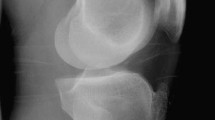Abstract
Summary
The term insufficiency fracture implies inadequate bone and is applied to some subchondral knee magnetic resonance images. We reviewed bone mineral density, body mass index, meniscal extrusion, comorbidities, and demographics in 32 knee insufficiency fracture patients. Only five were osteoporotic. Meniscal extrusion was predominant.
Purpose
The literature supports systemic osteoporosis as a risk fracture for spontaneous osteonecrosis of the knee (SONK). SONK is also called a subchondral insufficiency fracture. Recognizing that insufficiency fracture and SONK are related, we designed this retrospective study to determine if knee subchondral insufficiency fractures were associated with osteoporosis based on bone mineral density.
Methods
Based on magnetic resonance imaging findings, 32 patients were diagnosed as having an insufficiency fracture by an orthopaedic surgeon with magnetic resonance imaging confirmation by a musculoskeletal radiologist. We reviewed body mass index, age, sex, comorbidities, demographics, and bone mineral density using both T-scores and Z-scores.
Results
The average age was 70, and only five patients were osteoporotic. Twenty-six of the 32 patients were female. The average age-related Z-score was 1 standard deviation above normal.
Conclusions
We conclude that osteoporosis is not the underlying cause of this disorder in the majority of patients.



Similar content being viewed by others
References
Aspray TJ (2013) New horizons in fracture risk assessment. Age Ageing 42:548–554
Oyen J, Gjesdal CG, Brudvik C, Hove LM, Apalset EM, Gulseth HC, Haugeberg G (2010) Low-energy distal radius fractures in middle-aged and elderly men and women—the burden of osteoporosis and fracture risk: a study of 1794 consecutive patients. Osteoporos Int 21:1257–1267
Malluche HH, Porter DS, Mawad H, Monier-Faugere MC, Pienkowski D (2013) Low-energy fractures without low T-scores characteristic of osteoporosis: a possible bone matrix disorder. J Bone Joint Surg Am 95:e1391–1396
Kanis JA, Johnell O, Oden A, Johansson H, McCloskey E (2008) FRAX and the assessment of fracture probability in men and women from the UK. Osteoporos Int 19:385–397
Lingg GM, Soltesz I, Kessler S, Dreher R (1997) Insufficiency and stress fractures of the long bones occurring in patients with rheumatoid arthritis and other inflammatory diseases, with a contribution on the possibilities of computed tomography. Eur J Radiol 26:54–63
Lafforgue P, Daumen-Legre V, Clairet D, Daver L, Acquaviva PC (1996) Insufficiency fractures of the medial femoral condyle. Rev Rhum Engl Ed 63:262–269
Ahlbäck S (1968) Osteoarthritis of the knee: a radiographic investigation. Acta Radiol Diagn (Stockh) suppl 277:7–72
Ahlbäck S, Bauer GC, Bohne WH (1968) Spontaneous osteonecrosis of the knee. Arthritis Rheum 11:705–733
Ecker ML, Lotke PA (1994) Spontaneous osteonecrosis of the knee. J Am Acad Orthop Surg 2:173–178
Yamamoto T, Bullough PG (2000) Spontaneous osteonecrosis of the knee: the result of subchondral insufficiency fracture. J Bone Joint Surg Am 82:858–866
Kidwai AS, Hemphill SD, Griffiths HJ (2005) Radiologic case study. Spontaneous osteonecrosis of the knee reclassified as insufficiency fracture. Orthopedics 28(236):333–236
Cabarrus MC, Ambekar A, Lu Y, Link TM (2008) MRI and CT of insufficiency fractures of the pelvis and the proximal femur. AJR Am J Roentgenol 191:995–1001
Aratake M, Yoshifumi T, Takahashi A, Takeuchi R, Inoue T, Saito T (2009) Evaluation of lesion in a spontaneous osteonecrosis of the knee using 18F-fluoride positron emission tomography. Knee Surg Sports Traumatol Arthrosc 17:53–59
Scher C, Craig J, Nelson F (2008) Bone marrow edema in the knee in osteoarthrosis and association with total knee arthroplasty within a three-year follow-up. Skelet Radiol 37:609–617
Narvaez JA, Narvaez J, De Lama E, Sanchez A (2003) Spontaneous osteonecrosis of the knee associated with tibial plateau and femoral condyle insufficiency stress fracture. Eur Radiol 13:1843–1848
Zanetti M, Romero J, Dambacher MA, Hodler J (2003) Osteonecrosis diagnosed on MR images of the knee. Relationship to reduced bone mineral density determined by high resolution peripheral quantitative CT. Acta Radiol 44:525–531
Flynn MJ. Ksar JS. Blechinger JC. McGee RM (2007) Spatial response of x-ray tomosynthesis in relation to computed tomography. Paper presented at the Radiological Society of North America 2007 Scientific Assembly and Annual Meeting, Chicago, IL, November 25–30, 2007
Flynn M. McGee R. Blechinger J (2007) Spatial resolution of x-ray tomosynthesis in relation to computed tomography for coronal images of the knee. Medical Imaging 2007: Physics of Medical Imaging; 18–22 February 2007; San Diego, CA. SPIE, Bellingham, WA
National Institutes of Health (2000) Osteoporosis prevention, diagnosis, and therapy, vol 17. NIH Consens Statement, vol 1
Noyes FR, Stabler CL (1989) A system for grading articular cartilage lesions at arthroscopy. Amer J Sports Med 17:505–513
Satku K, Kumar VP, Chong SM, Thambyah A (2003) The natural history of spontaneous osteonecrosis of the medial tibial plateau. J Bone Joint Surg (Br) 85:983–988
Ramnath RR, Kattapuram SV (2004) MR appearance of SONK-like subchondral abnormalities in the adult knee: SONK redefined. Skelet Radiol 33:575–581
Ostlere SJ, Seeger LL, Eckardt JJ (1990) Subchondral cysts of the tibia secondary to osteoarthritis of the knee. Skelet Radiol 19:287–289
MacDessi SJ, Brophy RH, Bullough PG, Windsor RE, Sculco TP (2008) Subchondral fracture following arthroscopic knee surgery a series of eight cases. J Bone Joint Surg Am 90:1007–1012
Narvaez J, Narvaez JA, Rodriguez-Moreno J, Roig-Escofet D (2000) Osteonecrosis of the knee: differences among idiopathic and secondary types. Rheumatology (Oxford) 39:982–989
Naot D, Cornish J (2014) Cytokines and hormones that contribute to the positive association between fat and bone. Front Endocrinol (Lausanne) 5:70
Garino JP, Steinberg ME (1994) Etiology, diagnosis, and treatment of avascular necrosis of the femoral head. Curr Opin Orthop 5:3–10
Ethical approval
For this type of study, formal consent is not required.
Conflicts of interest
None.
Author information
Authors and Affiliations
Corresponding author
Rights and permissions
About this article
Cite this article
Nelson, F.R., Craig, J., Francois, H. et al. Subchondral insufficiency fractures and spontaneous osteonecrosis of the knee may not be related to osteoporosis. Arch Osteoporos 9, 194 (2014). https://doi.org/10.1007/s11657-014-0194-z
Received:
Accepted:
Published:
DOI: https://doi.org/10.1007/s11657-014-0194-z




